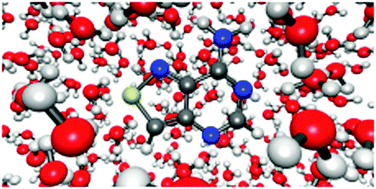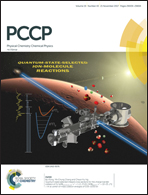Electronic structure and absorption spectra of fluorescent nucleoside analogues†
Abstract
This work presents a systematic investigation of the electronic and conformational properties of five new fluorescent nucleobases belonging to the alphabet based on the isothiazole[4,3-d]pyrimidine molecule, very recently synthesized. This is of particular importance in the characterization of the main electronic aspects of these fluorescent nucleosides. The solvent effects of 1,4-dioxane and water were included combining the Sequential Monte Carlo/CASPT2 and the Free Energy Gradient (FEG) methods. For comparison, the Polarizable Continuum method was also used. The geometries of all compounds were optimized in solvent with the largest effects observed in water using the average solvent electrostatic configuration (ASEC) and the FEG approaches. Statistical analysis of the solute–solvent hydrogen bonds is performed and their effect on the absorption spectra analyzed. The dipole moments were calculated and the value obtained from the ASEC-FEG method in water follows the same trend as the natural canonical bases (adenine → uracil → guanine → cytosine). The theoretical results for the absorption spectra obtained from CASPT2(18,13) calculations using the geometries obtained with the ASEC-FEG procedure are in very good agreement with the experimental data. A detailed elucidation of the main aspects of the absorption spectra of the five new fluorescent nucleoside analogues is successfully attempted.



 Please wait while we load your content...
Please wait while we load your content...